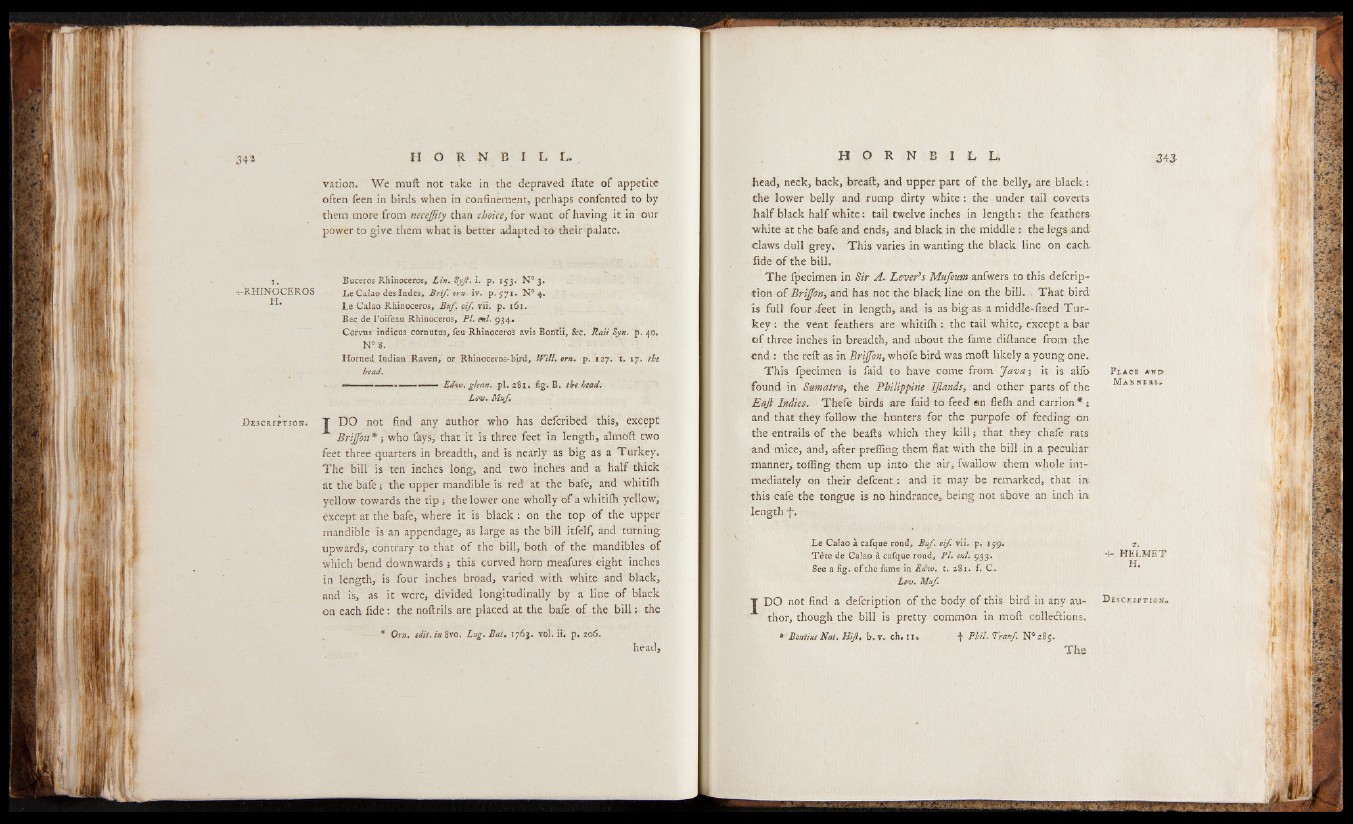
vation. We mud not take in the depraved Hate of appetite
often feen in birds when in confinement, perhaps confented to by
them more from necejjity than choice, for want of having it in our
power to give them what is better adapted to their palate.
i.
-i-RHINOCEROS
H.
Buceros Rhinocéros, Lin.Syft. i. p. 153. N° 3.
Le Calao des Indes, Bri/.orn.ïv. p. 571. N°4.
Le Calao Rhinocéros, Buf. pif. vii. p. 161.
Bec de l ’oifeau Rhinocéros, PI. ml. 934.
Corvus indicus cornu tus, feu Rhinocéros; avis Bontii, &c. Raii Syn. p. 40,
N° 8.
Horned Indian Raven, or Rhinocéros-b^rd, Will. ern. p. 127. t. 17. the
head. -
Ednu. glean. pi. 281. fig* B. the head.
Lev. Muf
T DO not find any author who has defcribed this, except
Brijfon* ; who fays, that it is three feet in length, aimed two
feet three quarters in breadth, and is nearly as big as a Turkey.
The bill is ten inches long, and two inches and a half thick
at thebafej the upper mandible is red at the bafe, and whitilh
yellow towards the tip j the lower one wholly o f a whitilh yellow,
except at the bafe, where it is black : on the top of the upper
mandible is an appendage, as large as the bill itfelf, and turning
upwards, contrary to that of the bill, both of the mandibles of
which bend downwards ; this curved horn meafures eight inches
in length, is four inches broad, varied with white and black,
and is, as it were, divided longitudinally by a line of black
on each fide: the noftrils are placed at the bafe of the b ill: the
Orn. edit, in 8vo. Lug. Bat• 1763. vol. ii. p. 206.
head, neck, back, breaft, and upper part of the belly, are black :
the lower belly and rump dirty white: the under tail coverts
half black half white: tail twelve inches in length: the feathers
■ white at the bafe and ends, and black in the middle : the legs and
claws dull grey. This varies in wanting the black line on each
fide of the bill.
The fpecimen in Sir A. Lever's Mufeum anfwers to this deferip-
tion of Briton, and has not the black line on the bill. That bird
is full four .feet in length, and is as big as a middle-fized Turkey
: the vent feathers are whitilh : the tail white, except a bar
o f three inches in breadth, and about the fame diftance from the
end : the reft as in Brijfon, whofe bird was moft likely a young one.
This fpecimen is faid to have come from Java; it is alfo
found in Sumatra, the Philippine JJlands, and other parts of the
Eajl Indies. Thefe birds are faid to feed en flefh and carrion * ;
and that they follow the hunters for the purpofe of feeding on
the entrails of the beafts which they kill j that they chafe rats
and mice, and, after preffing them flat with the bill in a peculiar
manner,, toffing them up into the air, fwallow them whole immediately
on their defeent: and it may be remarked, that in;
this cafe the tongue is no hindrance, being not above an inch in
length -f\
Le Caîao à calque rond, Buf. oif. yii. pT 159*
Tête de Calao à cafque rond, P l. enl. 933.
See a fig. of the fame in Edvj. t. 281. f. C-
Lev. Muf.
T DO not find a defeription of the body of this bird in any author,
though the bill is pretty common in moft collections.
* Bontius Nat. Hiß• b. v.- ch, 11* f PhiLTranf. N° 285.
P l a c e a n d -
M a n k eh s .
-f- HELMET
'H;
D e s c r i p t io n *